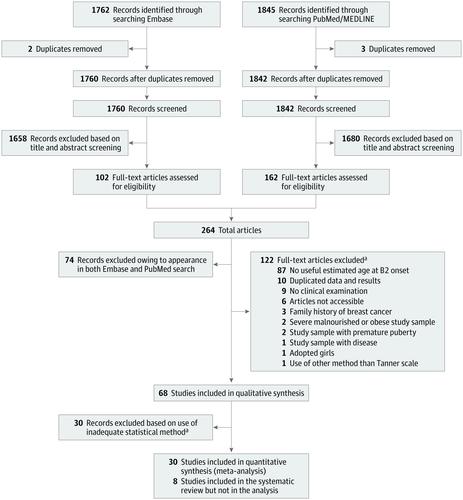当前位置:
X-MOL 学术
›
JAMA Pediatr.
›
论文详情
Our official English website, www.x-mol.net, welcomes your feedback! (Note: you will need to create a separate account there.)
Worldwide Secular Trends in Age at Pubertal Onset Assessed by Breast Development Among Girls
JAMA Pediatrics ( IF 26.1 ) Pub Date : 2020-04-06 , DOI: 10.1001/jamapediatrics.2019.5881 Camilla Eckert-Lind 1, 2 , Alexander S Busch 1, 2 , Jørgen H Petersen 1, 2, 3 , Frank M Biro 4, 5 , Gary Butler 6 , Elvira V Bräuner 1, 2 , Anders Juul 1, 2
JAMA Pediatrics ( IF 26.1 ) Pub Date : 2020-04-06 , DOI: 10.1001/jamapediatrics.2019.5881 Camilla Eckert-Lind 1, 2 , Alexander S Busch 1, 2 , Jørgen H Petersen 1, 2, 3 , Frank M Biro 4, 5 , Gary Butler 6 , Elvira V Bräuner 1, 2 , Anders Juul 1, 2
Affiliation

|
Importance
The initial clinical sign of pubertal onset in girls is breast gland development (thelarche). Although numerous studies have used recalled age at menarche (first menstruation) to assess secular trends of pubertal timing, no systematic review has been conducted of secular trends of thelarche. Objectives
To systematically evaluate published data on pubertal timing based on age at thelarche and evaluate the change in pubertal onset in healthy girls around the world. Data Sources
A systematic literature search was performed in PubMed and Embase of all original peer-reviewed articles published in English before June 20, 2019. Study Selection
Included studies used clinical assessment of breast development in healthy girls and used adequate statistical methods, including the reporting of SEs or CIs. The quality of the articles was evaluated by assessing study design, potential sources of bias, main characteristics of the study population, and methods of statistical analysis. Data Extraction and Synthesis
In accordance with PRISMA guidelines, all articles were assessed for eligibility independently by 2 authors. Weighted regression analysis was performed using a random-effects model. Main Outcomes and Measures
Studies examining age at thelarche (development of Tanner breast stage 2) in healthy girls. Results
The literature search resulted in a total of 3602 studies, of which 30 studies fulfilled the eligibility criteria. There was a secular trend in ages at thelarche according to race/ethnicity and geography. Overall, the age at thelarche decreased 0.24 years (95% CI, -0.44 to -0.04) (almost 3 months) per decade from 1977 to 2013 (P = .02). Conclusions and Relevance
The age at thelarche has decreased a mean of almost 3 months per decade from 1977 to 2013. A younger age at pubertal onset may change current diagnostic decision-making. The medical community needs current and relevant data to redefine "precocious puberty," because the traditional definition may be outdated, at least in some regions of the world.
中文翻译:

通过女孩乳房发育评估青春期发病年龄的全球长期趋势
重要性 女孩青春期开始的最初临床体征是乳腺发育(乳糜泻)。尽管许多研究使用回忆初潮年龄(第一次月经)来评估青春期时间的长期趋势,但尚未对早熟的长期趋势进行系统评价。目的 系统地评估已发表的基于乳头年龄的青春期时间数据,并评估世界各地健康女孩青春期开始的变化。数据来源 在 PubMed 和 Embase 中对 2019 年 6 月 20 日之前以英文发表的所有原始同行评审文章进行了系统的文献检索。 研究选择 纳入的研究使用了健康女孩乳房发育的临床评估并使用了充分的统计方法,包括报告SE 或 CI。通过评估研究设计、潜在偏倚来源、研究人群的主要特征和统计分析方法来评估文章的质量。数据提取和综合 根据 PRISMA 指南,所有文章均由 2 位作者独立评估是否合格。使用随机效应模型进行加权回归分析。主要结果和测量研究检查健康女孩乳头发育(Tanner 乳房发育 2 期)的年龄。结果 文献检索共检索到 3602 项研究,其中 30 项研究符合纳入标准。根据种族/民族和地理,乳头的年龄存在长期趋势。总体而言,从 1977 年到 2013 年,产乳年龄每十年减少 0.24 岁(95% CI,-0.44 至 -0.04)(近 3 个月)(P = .02)。结论和相关性 从 1977 年到 2013 年,产乳年龄平均每十年减少近 3 个月。青春期发病年龄的降低可能会改变当前的诊断决策。医学界需要最新的相关数据来重新定义“性早熟”,因为传统的定义可能已经过时,至少在世界某些地区是这样。
更新日期:2020-04-06
中文翻译:

通过女孩乳房发育评估青春期发病年龄的全球长期趋势
重要性 女孩青春期开始的最初临床体征是乳腺发育(乳糜泻)。尽管许多研究使用回忆初潮年龄(第一次月经)来评估青春期时间的长期趋势,但尚未对早熟的长期趋势进行系统评价。目的 系统地评估已发表的基于乳头年龄的青春期时间数据,并评估世界各地健康女孩青春期开始的变化。数据来源 在 PubMed 和 Embase 中对 2019 年 6 月 20 日之前以英文发表的所有原始同行评审文章进行了系统的文献检索。 研究选择 纳入的研究使用了健康女孩乳房发育的临床评估并使用了充分的统计方法,包括报告SE 或 CI。通过评估研究设计、潜在偏倚来源、研究人群的主要特征和统计分析方法来评估文章的质量。数据提取和综合 根据 PRISMA 指南,所有文章均由 2 位作者独立评估是否合格。使用随机效应模型进行加权回归分析。主要结果和测量研究检查健康女孩乳头发育(Tanner 乳房发育 2 期)的年龄。结果 文献检索共检索到 3602 项研究,其中 30 项研究符合纳入标准。根据种族/民族和地理,乳头的年龄存在长期趋势。总体而言,从 1977 年到 2013 年,产乳年龄每十年减少 0.24 岁(95% CI,-0.44 至 -0.04)(近 3 个月)(P = .02)。结论和相关性 从 1977 年到 2013 年,产乳年龄平均每十年减少近 3 个月。青春期发病年龄的降低可能会改变当前的诊断决策。医学界需要最新的相关数据来重新定义“性早熟”,因为传统的定义可能已经过时,至少在世界某些地区是这样。



























 京公网安备 11010802027423号
京公网安备 11010802027423号